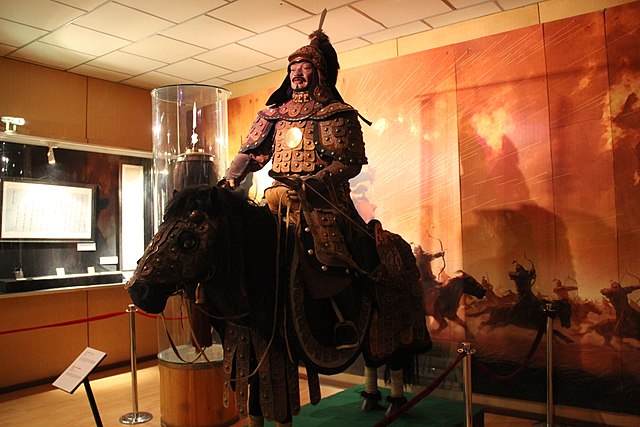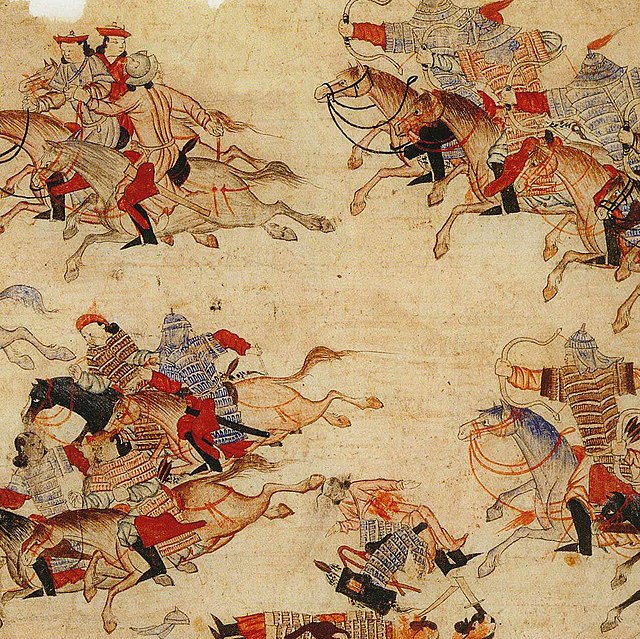The Mongols burst onto the world stage in the 13th century, carving out the largest contiguous land empire in history. Their conquests stretched from China to Eastern Europe, conquering major civilizations along the way. What made this nomadic people from the steepes of Central Asia into such a dominant military force? Several key factors came together to make the Mongol army seemingly unstoppable on the battlefield during their rapid expansion.
United Under Strong Leadership
The first key ingredient to the Mongols’ battlefield success was the strong leadership that united the normally fractious tribes together into a single fighting force. This began with Genghis Khan, born with the name Temüjin. Through a combination of military strategy, political alliances, and ruthlessness, Genghis Khan united the tribes under his rule by 1206, being declared the Great Khan.

Genghis Khan established a meritocracy, placing loyalty and ability over bloodlines when selecting generals and administrators. He also made great use of incentives to encourage allegiance, such as distributing plunder among loyal soldiers. This system of patrons and clients trickled down among the ruling class, making them personally invested in continued conquest.
After Genghis Khan’s death, the empire continued expanding under his successors Ögedei, Güyük, and Möngke. This continuity of strong leadership maintained the cohesiveness of the imperial forces. Several Khans displayed similar military and political prowess as Genghis, keeping the Mongol army as the dominant fighting force from Russia to Persia.
Highly Disciplined Cavalry
Another key to the Mongols’ battlefield prowess was their cavalry forces. Mongols learned to ride almost as soon as they could walk. They were expert horsemen and archers, able to shoot arrows with deadly accuracy even while mounted. The extreme mobility and speed of their cavalry allowed them to outmaneuver opponents quickly.
Discipline was ingrained in Mongol warriors starting in childhood. They were conditioned to have an unquestioning obedience to authority. Mongol forces operated with precision, able to execute complex battle plans adeptly by patiently biding time before suddenly attacking en masse.

The mobility of Mongol forces also allowed them to fight for prolonged periods, attacking when least expected and fading away before opponents could mount a defense. With stellar communication through a relay horseback messenger system called Örtöö, commanders maintained tactical control of distant units spread across the landscape.
Adaptability and Innovation
The Mongols quickly recognized they lacked the knowledge needed to conduct lengthy siege warfare and naval operations required to capture major cities. Rather than seeing this as an inadequacy, they displayed immense adaptability to incorporate tactics and technology from conquered peoples to address these gaps.
As they expanded into China, Central Asia, and the Middle East, the Mongols eagerly recruited siege engineers, shipbuilders, and doctors from urban populations under their rule. Engineers developed superior counterweight trebuchet catapults capable of hurling heavy projectiles to smash down fortified walls and citadels that would have otherwise halted their advance. Navies hastily constructed allowed them to eliminate safe harbors and trade routes for enemies. They created elaborate intelligence networks to plan attacks knowing their opponents’ movements in advance. The Mongols embraced any technology or tactics that furthered their military goals.
Psychological Warfare
The Mongols deliberately terrorized populations into surrender through extreme, often cruel violence. Cities resisting their demands to capitulate were made examples, massacring inhabitants or burning them to the ground. Tales spread quickly of cities like Kiev, Samarkand, and Baghdad being leveled, their populaces butchered, creating what is now called the “arrows fall like rain” effect. This demoralized defenders, cities often surrendering quickly to the Mongol horde appearing outside their gates rather than face complete annihilation.

The Mongols also used spies extensively, further adding to their terrifying mystique. Enemy agents were double crossed and exploited for intelligence. Networks of spies fedDetailed intelligence let Mongol forces exploit weaknesses and strike enemies where when they least expected. This fearsome combination of military prowess and deliberate cultivation of terror made them appear unbeatable.
Logistical Mastery
Supporting large military campaigns far from native lands usually stretched premodern armies to their limits. Armies often had to pillage enemy lands for provisions just to survive extended campaigns. In contrast, the Mongols operated with precise logistics that allowed them to judiciously stockpile resources using a network of well-guarded supply depots.
Herds of cattle, sheep and horses provided traveling provisions. Fodder in large quantities kept mounts healthy even on lengthy campaigns. This kept Mongol forces highly mobile, not reliant on ripe agricultural lands for provisions. Their sturdy stock ponies were replaced by fresh mounts from reserves allowing battles to continue nonstop for days.
They also paid close attention to intelligence reports, attacking weaker isolated enemy forces and avoiding costly direct engagements against superior defensive positions when possible. These advantages amplified their military might considerably, letting them pick and choose when to unleash their full ferocity strategically against dispirited foes.
United, Disciplined, Innovative and Ruthless
The Mongols seemed unstoppable on the medieval battlefield because of the rare combination of strengths they could leverage. Disciplined and mobile cavalry forces executed well-planned battles under strong leadership. Embracing innovation expanded their combat capabilities. By weaponizing terror psychologically while mastering logistics, they could overwhelm enemies across terrain and distance at times of their choosing. These interlocking factors that fed into each other made their combat forces incredibly difficult to counter effectively, earning their fearsome reputation that still amazes military historians today. Their united focus on conquest eventually crumbled from within due to factionalism among Genghis Kahn’s feuding descendants, ending what seemed like would become a world empire spanning from sea to sea.
Sources
Boyle, J. A. (2015). Genghis Khan and Mongol Intelligence. Routledge.
Chambers, J. (1999). The Devil’s Horsemen: The Mongol Invasion of Europe. Atheneum.
May, T. (2012). The Mongol Art of War. Westholme Publishing.
Morgan, D. (1990). The Mongols (Peoples of Europe). Blackwell Publishers.
Weatherford, J. (2005). Genghis Khan and the Making of the Modern World. Three Rivers Press.